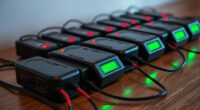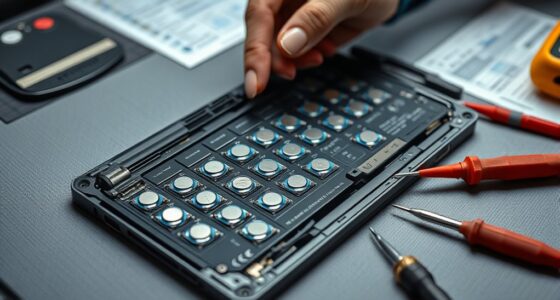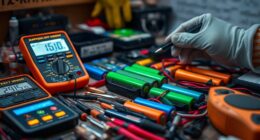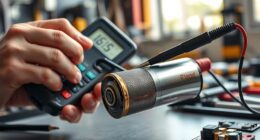Tracking your reconditioning sessions helps you see your progress clearly, so you can make smarter adjustments to your plan. Consistent logging keeps you on schedule, guarantees accurate data through proper equipment calibration, and highlights small improvements or setbacks. This detailed record-keeping boosts motivation and prevents setbacks caused by irregular activity. Overall, data-logging turns your recovery into a strategic process, helping you stay focused and motivated — if you want to know how to optimize this even further, keep going.
Key Takeaways
- Accurate data tracking reveals recovery progress and guides necessary adjustments to training routines.
- Consistent logging ensures adherence to schedules, promoting steady improvement and habit formation.
- Proper equipment calibration guarantees measurement reliability, preventing misleading progress assessments.
- Detailed records highlight small gains, early signs of overexertion, and help set realistic recovery milestones.
- Overall data logging transforms sessions into strategic, measurable efforts that enhance motivation and recovery outcomes.
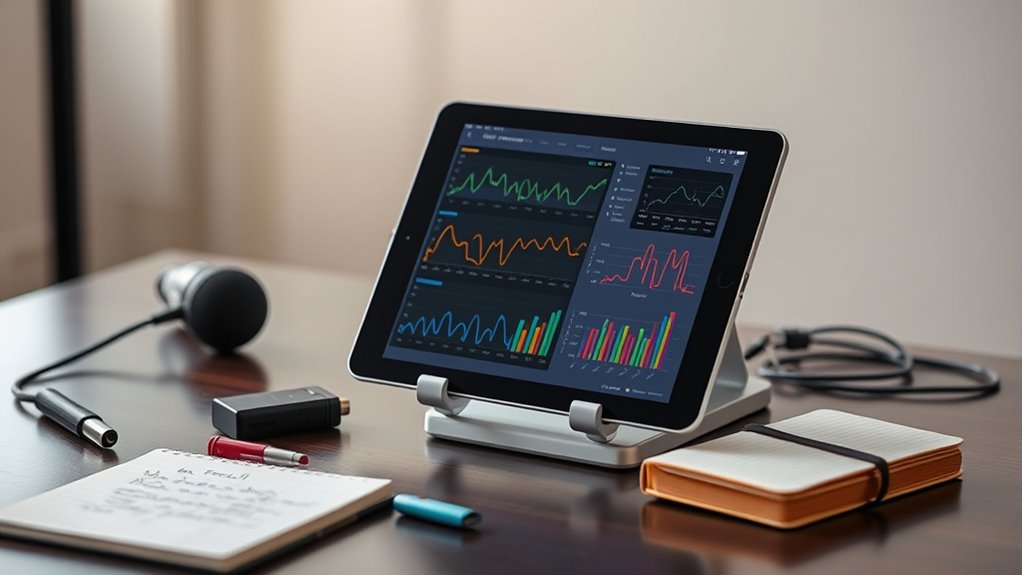
Reconditioning sessions are most effective when you track your progress systematically. By doing so, you gain a clear understanding of how your efforts are shaping your recovery, allowing you to make informed adjustments along the way. One of the key factors in maintaining this consistency is paying close attention to session consistency. When you log each session, you can guarantee that you’re sticking to your planned schedule, whether that’s daily, weekly, or bi-weekly. Consistency is essential because it helps your body adapt gradually without risking injury or overtraining. When you review your logs, you’ll notice patterns—such as improvements in strength or flexibility—that only emerge when your training remains steady over time. This regularity also prevents you from unintentionally skipping sessions, which can hinder progress and prolong recovery.
Another aspect that plays a crucial role in accurate data-logging is equipment calibration. Correctly calibrated equipment means that the measurements you record are precise and reliable. If your devices aren’t properly calibrated, your logs could reflect inaccurate data, leading you to make misguided adjustments or push too hard. For example, if your resistance bands or machine settings aren’t calibrated correctly, you might think you’re working at a certain intensity when, in reality, you’re not. Over time, this can throw off your entire progress tracking, making it harder to determine your true capabilities or setbacks. Consequently, regularly checking and calibrating your equipment guarantees that each session’s data is trustworthy. When you combine session consistency with properly calibrated equipment, your logs become a powerful tool for fine-tuning your reconditioning program.
Keeping detailed records also helps you identify what’s working and what isn’t, especially when you’re aiming for specific goals like regaining strength or improving mobility. When you document every session, including notes on how you felt, the exercises performed, and the intensity used, you create a thorough picture of your recovery journey. This detailed log allows you to recognize small improvements that might otherwise go unnoticed, providing motivation to keep going. It also helps you catch early signs of overexertion or plateaus, so you can adjust your plan before setbacks occur. Ultimately, systematic data-logging turns your sessions into a strategic process rather than just routine activity. It empowers you to make smarter decisions, stay motivated, and achieve better outcomes in your reconditioning efforts.
Additionally, understanding how Glycolic Acid benefits skin health can help you tailor your skincare routine to support your recovery process by keeping your skin healthy and resilient.
Frequently Asked Questions
What Specific Devices Are Best for Data-Logging During Reconditioning?
When choosing devices for data-logging during reconditioning, you want options with strong device compatibility and reliable data security. Look for rugged tablets like the Samsung Galaxy Tab Active series or specialized data loggers such as the Fluke 289. These devices offer seamless integration with your systems and guarantee your logs stay secure. Prioritize those that support your existing tools and provide encryption features to keep your data safe.
How Often Should I Review My Logged Data?
Think of your logs as a compass guiding your journey; their true value lies in consistent checking. You should review your logged data at regular intervals, ideally weekly or after each session, to catch patterns early. Tracking frequency helps you fine-tune your approach, ensuring you stay on course. By setting clear review intervals, you transform raw data into actionable insights, keeping your reconditioning progress steady and purposeful.
Can Data-Logging Help Prevent Overtraining?
Data-logging can definitely help prevent overtraining by tracking your training progress. When you monitor your sessions regularly, you’ll notice signs of fatigue or overexertion early, allowing you to modify intensity or rest accordingly. This proactive approach supports injury prevention and ensures you stay on track with your goals. Consistent data logging makes it easier to find the right balance, so you avoid pushing too hard and risking setbacks.
What Privacy Concerns Are Associated With Data-Logging?
Imagine your fitness app shares your workout data without your consent. When you data-log your reconditioning sessions, you raise privacy concerns like data privacy and personal security. Unauthorized access or breaches could expose sensitive health info or habits. You need to understand how your data is stored and protected, ensuring your personal info stays secure. Being aware of these risks helps you make informed choices about sharing your data.
How Do I Interpret Complex Data Logs Effectively?
When you interpret complex data logs, focus on data pattern analysis to spot recurring behaviors or anomalies. Look for trends over time, such as improvements or setbacks, to understand progress. Break down the data into smaller sections if needed, and compare different variables. Use visualization tools like graphs to identify patterns visually. This approach helps you make informed decisions and adjust your reconditioning plan effectively.
Conclusion
By diligently documenting your reconditioning sessions, you’ll develop a deeper understanding of your progress and pinpoint potential problems. Consistent data-logging cultivates clarity, confidence, and continuous improvement. Don’t delay—dedicate yourself to detailed records and discover the difference it makes. Remember, steady, structured logs support stronger, smarter, and more successful sessions. Stay committed, stay consistent, and watch your progress propel forward with purpose and precision!


